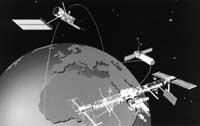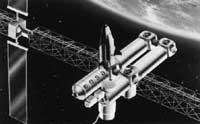ESA: Europe in space
In discussing the most important space projects in previous decades, in general, we should mention the programs organized by the United States or the Soviet Union. Until a few years ago these two powers have been the vanguard of space flight research. However, in the coming years the situation will change quite a bit.
The eleven Member States of the European Space Agency (ESA), Germany, Austria, Belgium, Denmark, Eire, United Kingdom, Spain, France, the Netherlands, Italy, Norway, Sweden and Switzerland, which are part of the missing Soviet Union, together with their two Finnish Powers, have subsequently established bases of collaboration.

This year marks the 20th anniversary of the decision to create ESA on July 31. The last agreement that gave ESA legal structure was signed on October 30, 1980. The objectives of the work entrusted to the Agency in these meetings are fully peaceful: on the one hand, the research of space, the development of space technology and the study of its applications for scientific purposes, and, on the other, the design of operational systems of space research. At this last meeting in Brussels, the Ariane, Spacelab and Marots programs were approved.
In order to meet these objectives, ELA has organized a particular European planning by touching a wide range of fields, such as pure sciences, research on microgravity, the observation of the Earth, telecommunications, the platforms of commissioning, the means of transport towards it and the terrestrial infrastructures.
For twenty years ESA has launched ten satellites for scientific purposes (specifically, to better know the universe). Special mention should be made of the COS-B and EXOSAT satellites. On the other hand, there are four satellites currently working: Space telescope IVE, Giotto, Ulysses and Hubble.
Likewise, the participation of ESA in the missions of the Spacelab space laboratory and in the microgravity experiments carried out in it, or the work of the Eureka satellite, has been of great importance. This latest platform, launched on July 31 of last year, is the largest space vehicle built and put in orbit by ESA. There were seventy and one experiments designed by scientists from eight European states. This satellite was recovered on June 24 by the replacement of Endeavour. Another satellite that has given very good results has been Hipparcos. The communication was cut last August after three years of work (half a year more than expected).
Undoubtedly, one of the most important challenges to achieve an autonomous spatial policy is that of flights equipped with people. Significant advances have also been made in this field. Last November, ten years have passed since the first European astronaut toured the space, at the Spacelab, which was also the first trip for this laboratory. This year, on April 26, the Spacelab D-2 laboratory was launched inside the Columbia space wedge. This has been the second flight, equipped with people, that the DLR, the Germanic Organization for the Investigation of Space, has assumed totally successfully.
As for pitchers, those from 1 to 4 of the Ariane series have had a great economic success. Half of the commercial satellites in orbit are orbitados by some Ariane.
In the future, they intend to carry out more and more complete and difficult missions. Among them is the Spacelab D-3 mission, with a research program in conditions of no weight. Meteosat and ERS satellites for Earth and Environment observation are being designed, there are many launches for telecommunications: OTS, MARECS, ECS, DRS, ARTEMIS, etc.
Many scientific goals will be put into orbit in the next ten years: ISO, to study the Universe in the field of infrared; the four probes of the SOHO and CLUSTER programs will analyze the solar wind and its influence on the magnetosphere of the Earth; it will be sent along with the platform Cassini-Huygens to Saturn to send us data on the largest moon of this planet (the Titanium).
However, the most striking of all the projects that will become indicators of the maturity of the ESA are those corresponding to the series of stations Columbus and the transport formed by launchers Ariane 5 and Hermes wedges. The first previews the construction of three stations. The first is Columbus Attached Laboratory, or in summary CAL. This laboratory is a European contribution to the international space station FREEDOM and will be designed to have a life of thirty years. It will be used mainly to investigate the behavior of the fluid, some materials and human bodies in conditions of absence of weight.

On the other hand, the Columbus Polar Platform (Columbuz polar platform) or the CPP satellite will be launched to investigate the Earth. It will work on an 800 km high orbit and will be equipped with instruments to perform various measurements of the atmosphere, continents, seas and ice.
Finally, Columbus Free Flight Laboratory (Columbus Free Flight Laboratory, CFFL) will be like FREEDOM or the Russian MIR station that has been working for a long time.
The transport that these projects need, as we said before, is formed by Ariane 5 and Hermes. Ariane 5 does not resemble much to 4 and will overcome it in all aspects. It will have a single main motor and two side supports. One of the most important distinctives will be its reliability, since being a pitcher of Hermes must guarantee the safety of his astronauts. It has also been designed for the transport of commercial satellites, not just one but two. With this particularity, the reduced cost and reliability that we have mentioned, make economic success fully guaranteed.
The Hermes bucket is designed for three astronauts, can not transport more than 3 tons each time and will not have ports to allow to recover the satellites, but, in return, half of NASA's Space Shuttl will be more moderate and economical. It will also be very adaptable and safe. The duration of the ordinary missions to be carried out is ten days, and although IDA planning includes two flights a year, up to three may be made. They think it has a life of thirty years.
Due to the current crisis situation, it is not possible to establish a fixed date for the aforementioned projects. Hermes has been one of the programs with the highest budget constraint. Therefore, it will be necessary to modify the year referred to at the beginning, 2003, to organize a fully European mission, equipped with people.
Anniversaries SUN: Winter begins on December 21. 20 h to 26 min (UT).
PLANETS MERCURY: If it is not early in the first week of the month we will not be able to see it. ARTIZARRA: as it goes towards the conjunction we will not be able to see Venus. MARTITZ: it's in conjunction on December 27, so we won't see either. One hour before the first rays of the Sun at the beginning of the month. In the end, even three hours before. Jupiter will be getting better to see it. On the other hand, Saturn goes in the reverse way. However, in December we will still be able to see it well, nothing more darkening. At the beginning of the month we can see about four hours and in the end only two. |
Buletina
Bidali zure helbide elektronikoa eta jaso asteroko buletina zure sarrera-ontzian











